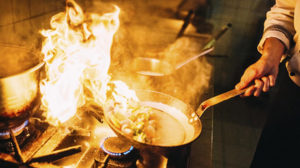
There are many ways to prevent a kitchen fire. For instance, no fabrics or flammable items should remain within three feet of a stove or oven for prolonged periods of time. This includes towels, pot holders, oven mitts, and paper towels. Wearing loose clothing while working at a stove or oven should be avoided, as clothing may touch a gas or electric burner and catch on fire. Wiping burners and other surfaces on stoves or inside ovens is also necessary to clean off oil, food particles and other materials which may catch fire when the coils or burners get hot. If there are things residing in cabinets above the stove, remove them for use before starting to cook food, this will prevent clothes from catching on fire while reaching over a hot burner to retrieve items. Utensils containing metal, aluminum or foil, or other metal-based objects, should be kept away from the microwave oven. Never place paper-based materials inside an oven, unless the product’s instructions say to do so, as they may catch on fire at high temperatures. Exceptions may include items such as pizza trays that are made for use within the oven. Removing items from microwaves should be done with a pot holder, as they can be very hot. When using cooking oil, the safest way to heat it is on medium rather than high, to mitigate the potential for oil catching on fire. Leaving food cooking on stoves is generally unsafe as it is possible for food to catch on fire unexpectedly. Soups cooking in pots, or rice simmering in saucepans, are notable exceptions; however it is never safe to leave food cooking in a skillet, especially in oil. Kitchen appliances with frayed or damaged cords should not be plugged in and get replaced, because this elevates the risk of short circuits and an electrical fire.
Children should never be allowed to cook in the kitchen until they are old enough to stand over the stove and see the entire stove clearly. Furthermore, children must first become familiar with the rules of kitchen safety before attempting to cook, and they should always do so only under adult supervision. Anyone who works in a kitchen should familiarize themselves with the type of fire extinguisher that is necessary to fight kitchen fires. These are known as ABC fire extinguishers, or dry chemical extinguishers. These are suitable for putting out ordinary fires as well as those involving flammable fluids such as cooking oil. The method for using a fire extinguisher is called PASS, which stands for pulling the pin, aiming the extinguisher, squeezing the trigger, and sweeping the area where the fire is located, namely the base of the fire, rather than just the flames. Care should be taken, especially during large cooking projects, which typically occur during the holidays. During these periods, the number of kitchen fires is higher than normal.
In Case of a Kitchen Fire
If a kitchen fire breaks out, it is important to know how to extinguish the blaze, or if necessary, how to evacuate. Because fires can break out anywhere, including the oven, it is necessary to have a working smoke detector and to routinely test it to ensure it is in working condition. If a fire emergency does occur, it is also important to know what kind of fire has broken out. Some fires are caused by burning paper or fabrics, while others are caused by hot grease. Unlike other fires, grease fires cannot be put out with water, and in fact water will only make the fire much worse. The way to put out grease fires is to either cover the skillet or pot with a damp cloth, or to pour baking soda over the fire. If the fire is too big for those options, then it needs to be put out with an ABC fire extinguisher. However, if the fire is too big for a fire extinguisher, the safest option is to evacuate and call the fire department by cell phone or at a neighbor’s house. The residents or family should have an escape plan practiced and ready in case of a fire, so that they can evacuate safely and gather at a predetermined meeting place.
Visit Homeadvisor’s Website for Preventing Kitchen Fires for the full article and for several more links regarding home fire safety.
Want to learn more about your community volunteer fire department and its citizen volunteers? Then check out our ABOUT STAR CITY VFD PAGE. Want to learn more about becoming a citizen volunteer and helping the residents of Monongalia County? Visit our MEMBERSHIP and RECRUITMENT pages.
And as always, ‘LIKE’ us on FACEBOOK and follow us on INSTAGRAM by searching ‘starcityvfd’